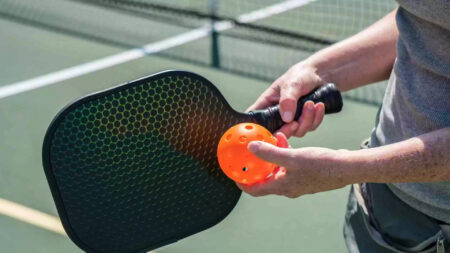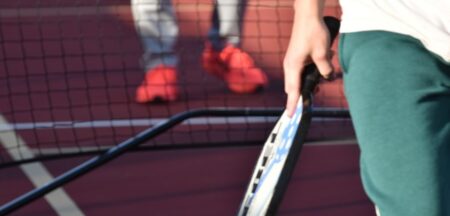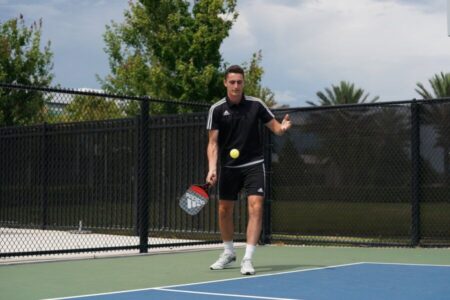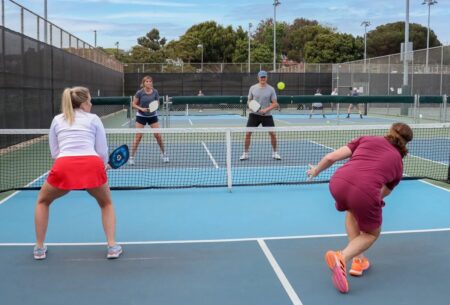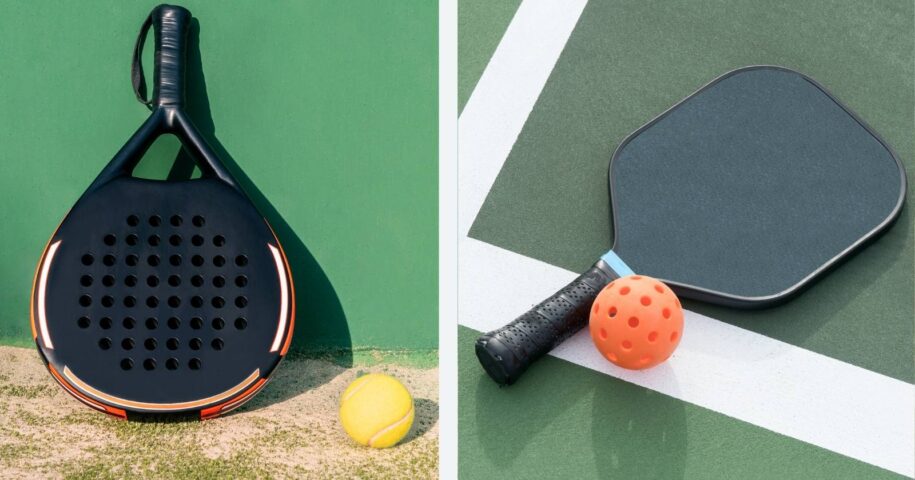
Are you curious about the differences between paddle ball and pickleball? Well, look no further! In this article, we will delve into the unique characteristics of these two popular racquet sports.
From equipment to court dimensions, scoring systems to playing techniques, we will cover it all. Whether you’re a seasoned player looking to expand your skills or a beginner trying to decide which sport to pick up, this article is for you.
So, grab your racquet and get ready to explore the nuances of paddle ball vs pickleball. By the end, you’ll have a clear understanding of what sets these two sports apart and be well equipped to make an informed choice about which one suits you best.
Key Takeaways
- Paddle ball offers more power and control with a larger, heavier paddle and rubber ball, while pickleball is easier to maneuver and control with a smaller, lighter paddle and plastic ball with holes.
- Paddleball equipment includes a paddle with reduced air friction, a slightly rounder shape for a larger hitting surface, and small, soft rubber tennis balls. Pickleball equipment consists of a paddle made of wood, plastic, or composite materials with a graphite face, a more rectangular shape for easier maneuverability, and lightweight, hollow, perforated plastic balls.
- The court dimensions for paddle tennis are 50 feet long, while pickleball courts are 20 feet wide and 44 feet long, demanding quick reflexes and precise shots. Paddleball courts are 34 feet long and 20 feet wide, with walls for added strategy.
- Paddleball and pickleball rackets are not interchangeable, as they are specifically designed for each sport based on court dimensions and gameplay. Paddleball follows a scoring system similar to racquetball, with games played to 11 points and only the serving team able to score, while pickleball has a unique scoring system where both teams can score.
Paddle ball Vs Pickleball
Looking to up your game? Discover the key differences between paddle ball and pickleball!
Paddle ball is a fast-paced game played with a solid paddle and a rubber ball. It is typically played outdoors on a beach or in a park. The paddle used in paddle ball is larger and heavier than the one used in pickleball, which allows for more power and control. The rubber ball used in paddle ball is also denser, making it bounce higher and faster.
On the other hand, pickleball is a slower-paced game played with a smaller and lighter paddle and a plastic ball with holes. It is commonly played on a smaller court, either indoor or outdoor. The lighter paddle and plastic ball in pickleball make it easier to maneuver and control.
Equipment
When playing with a paddleball, you’ll feel the air flowing through the holes in the paddle, creating a sense of lightness and agility in your hands. This is one of the key differences between paddleball and pickleball. Paddleball paddles have holes to reduce air friction, while pickleball paddles do not. This feature makes paddleball a unique and exciting game to play.
Pickleball paddles, on the other hand, are made of wood, plastic, or composite materials with a graphite face. They are designed to be sturdy and durable, allowing players to hit the ball with power and control. The absence of holes in the paddle gives pickleball a different feel compared to paddleball.
Another difference lies in the shape of the paddles. Paddleball rackets are typically a slightly rounder shape, providing a larger hitting surface. This can be advantageous for beginners who are still working on their accuracy and aim. On the other hand, pickleball paddles have a more rectangular shape, making it easier to maneuver and control the ball.
In terms of balls, paddleball uses small, soft rubber tennis balls, while pickleball uses lightweight, hollow, perforated plastic balls. The different materials and construction of the balls result in different levels of bounce and speed, which can impact gameplay strategy.
Court Dimensions
Get ready to step onto the court and experience the unique dimensions of both paddleball and pickleball! When it comes to court dimensions, paddle tennis and pickleball have distinct differences.
Paddle tennis courts are 50 feet in length, providing plenty of space for players to move around and engage in fast-paced rallies.
On the other hand, pickleball courts are similar in size to a badminton court, measuring 20 feet wide and 44 feet long. The smaller court size in pickleball requires players to have quick reflexes and precise shots to navigate the limited space effectively.
Paddleball courts, on the other hand, have a different dimension altogether. They are 34 feet long and 20 feet wide, with four walls surrounding the playing area, similar to a racquetball court. This unique layout adds an extra level of strategy and challenges players to utilize the walls to their advantage.
Now, you might be wondering if you can use a paddle ball racket for pickleball or vice versa. The answer is, unfortunately, no. Paddleball and pickleball rackets are specifically designed for their respective sports, taking into account the different court dimensions and gameplay. So, it’s essential to use the appropriate racket for each sport to ensure a fair and enjoyable game.
The court dimensions play a crucial role in shaping the gameplay of both paddleball and pickleball. The larger size of paddle tennis courts allows for more movement and longer rallies, while the smaller dimensions of pickleball courts demand precision and quick reflexes.
Scoring System
In paddleball, the scoring system is similar to racquetball. The game is played to 11 points, and only the serving team can score. If the serving team wins a rally, they get a point and continue to serve. If the receiving team wins a rally, they gain the serve but do not score a point. The first team to reach 11 points, with a margin of at least two points, wins the game.
On the other hand, pickleball has a unique scoring system. Games are played to 11 points, but unlike paddleball, both the serving and receiving teams can score. The serving team must win the rally to score a point. If the receiving team wins the rally, they gain the serve but do not score. Similar to paddleball, the first team to reach 11 points, with a margin of two points, wins the game.
Playing Techniques
Mastering the playing techniques in both paddleball and pickleball will elevate your skills and make you a formidable opponent on the court. While both sports involve the use of a paddle, there are some key differences in how the paddle is used and the techniques employed.
In paddleball, the swing length is longer compared to pickleball. This is because paddleball allows for a greater range of motion, enabling players to generate more power and speed when hitting the ball. The technique in paddleball involves a full body swing, with players using their wrists, arms, and shoulders to generate the necessary force. This allows for powerful shots and the ability to hit the ball deep into the court.
On the other hand, pickleball has a shorter swing length due to the restrictions imposed by the non-volley zone. The non-volley zone, also known as the kitchen, prohibits players from standing within a certain area near the net while volleying the ball. As a result, pickleball players focus more on quick wrist movements and precise shots rather than relying on power. The technique in pickleball involves a shorter backswing and a compact follow-through, allowing for better control and placement of the ball.
Another difference in playing techniques between paddleball and pickleball is the positioning of the paddle. In paddleball, the paddle is typically held with a grip similar to that of a tennis racket, allowing for greater flexibility in shot selection. In pickleball, however, the paddle is held with a more firm grip, enabling better stability and control during gameplay.
Conclusion
So there you have it! Now you know the differences between paddle ball and pickleball.
Hopefully, this article has helped you understand the variations in equipment, court dimensions, scoring system, and playing techniques.
Whether you prefer the fast-paced action of paddle ball or the strategic gameplay of pickleball, both sports offer a fun and exciting way to stay active and enjoy some friendly competition.
Frequently Asked Questions
Are there any age restrictions or recommended age groups for playing paddle ball or pickleball?
There are no age restrictions for playing paddle ball or pickleball. Both games can be enjoyed by people of all ages. However, some organizations may have specific recommendations for certain age groups.
Are there any specific attire or dress code requirements for playing paddle ball or pickleball?
There is no specific attire or dress code requirement for playing paddle ball or pickleball. However, it is recommended to wear comfortable athletic clothing and shoes that provide good traction on the court.
Can paddle ball or pickleball be played indoors or is it strictly an outdoor sport?
You can play paddle ball or pickleball both indoors and outdoors. It is not strictly an outdoor sport. The choice of playing location depends on your preference and the availability of suitable facilities.
Are there any specific rules or regulations regarding the use of paddles or rackets in paddle ball or pickleball?
There are specific rules and regulations regarding the use of paddles or rackets in both paddle ball and pickleball. It is important to follow these rules to ensure fair play and a safe playing environment.
Can paddle ball or pickleball be played in a doubles format or is it only played as singles?
Yes, both paddle ball and pickleball can be played in a doubles format. You can team up with a partner and play against another pair, adding a fun and social element to the game.
